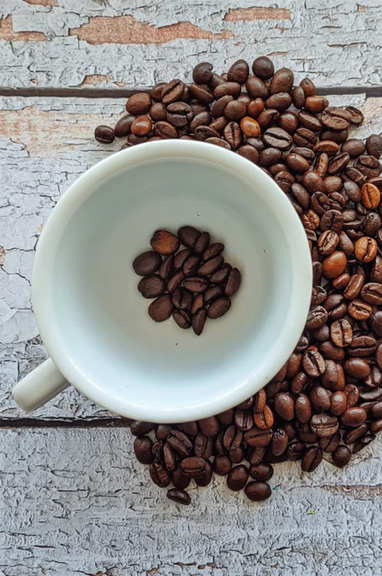Πόσο δύσκολο είναι το καβούρδισμα στο σπίτι;

Μια δύσκολη, αλλά συναρπαστική διαδικασία.
It is a fact that in recent years, a Do It Yourself trend is beginning to prevail in the field of coffee. Many coffee makers, both for financial reasons and looking for more "natural" products, but also wanting to put into practice the knowledge they have gained from so many years of reading and tasting, end up with homemade mixes, homemade extracts, even homemade roasting .
The world of coffee, however, is very complex and nothing is as simple as it seems. Roasting is a fun process, but it may be best to leave it to the experts, so we analyze the steps and difficulties that an amateur roaster will face.
Τα καθοριστικά βήματα για επιτυχή καβουρδίσματα στο σπίτι
 A) Purchase of Green Coffee
A) Purchase of Green Coffee
The first step in home roasting is to buy green (unroasted) coffee. Although green coffee is generally cheaper than packaged, roasted coffee, this is true for large markets and wholesalers. In practice, a coffee lover who wants to roast small amounts of coffee for personal use will find it difficult to find good quality roasted coffee at a good price.
In the supply of green coffee, the internet is almost a one-way street, with the exception of specialized coffee grinders that may have small quantities of green coffee by arrangement. Many coffee makers are looking for like-minded people in order to place larger orders, dropping the cost, while caution is required, because unroasted coffee available in small quantities (and not to wholesalers) is often of inferior quality, or has defects that a non- trained eye.
B) Choice of roasting method
For beginners, who want to start roasting coffee at home, the most common methods are: roasting in the pan, roasting in the oven and roasting on a popcorn machine.
Roasting in the pan is the simplest method, however it requires strength in the hands, experience and absolute control of the temperature (hence, a good kitchen). However, it is definitely the most appropriate way for someone to get in touch with the roasting process and learn to recognize the "signs" that the coffee itself gives (aroma, sounds, color change, etc.). After a few failed roasts, the experience will slowly begin to be conquered.
Roasting in the oven requires a good oven with controlled airflow and great attention to temperature, but it also requires experience in order to know when to stop the process. Finally, popcorn machines are simple, easy to use for beginners and economical, but offer a limited degree of control over the process, while special care is required, as when using an electric machine for a purpose other than the one for which it was made, there is always risk of accident.
Of course, there is the possibility of buying a roasting machine, similar to those used by coffee grinders, but the cost is significantly higher, as expected.
 C) Selection of space
C) Selection of space
Of course, most amateur roasters use their own kitchen, but there are always some factors to keep in mind. Our space should be simple, offering freedom of movement, good ventilation and safety valves in case something overheats. Also, all additional equipment (green coffee, spoons, storage containers, gloves, thermometers, etc.) must be immediately accessible on site.
D) Selection of degree of roasting
Roasting coffee usually takes from 7 to 14 minutes, depending on the variety, the intensity of the fire and the taste profile we want to give to our beans. More time on the fire results in a darker roast, with the corresponding taste characteristics, while a light roast, ie for a short time, highlights different aspects of the coffee.
What roast we choose depends on both our taste and the coffee we have available. Due to the fact that most green coffees are single-origin, light roasting is recommended, which will emphasize the organoleptic characteristics of the coffee. Alternatively, we can roast different varieties of coffee to whatever degree we want, and then try our hand at home blending.
What are the main difficulties of home roasting?
Home Roasting is a very difficult process, which, although it drives some coffee hobbyists crazy, may not have much to offer the average coffee drinker. Initially, the purchase of raw materials is difficult, the options are limited and the quality is often questionable. Also, equipment is required, but also space, while due to its nature, roasting is a process that involves risks (smoke, high temperatures, etc.). Most importantly, however, proper roasting requires experience, which is extremely difficult to gain through home testing.
Proper roasting is a process that relies heavily on the "hand" and the "eye". While of course a controlled environment and control of key factors such as temperature and time are required, many roasters understand the process based on factors such as aroma, color and sound. Such an experience is difficult to obtain through homemade roasting.
Also, experience is required to choose the degree of roasting that suits each different variety of coffee. Sure, coffee is a matter of taste, but the blenders and roasters of the big companies are people who have dedicated their lives to detecting the subtle flavors of coffee, and deciding on small details in roasting, but they can make a real difference. Finally, the equipment used by professionals can not even be accessed by an amateur, since the cost and space make any relevant thought prohibitive.
Roasting at home is a process that is aimed primarily at hobbyists, those who want to find in it a creative activity and a way to spend their time happily, but it hardly ends up with better results than a quality blend that we would buy. Of course, it continues to be an impressive hobby, which with its obsession with detail gains more and more friends.










